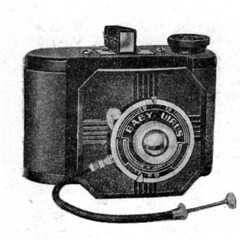Baby Uirus
The Baby Uirus is a Japanese 3×4cm bakelite camera made in the late 1930s and early 1940s by Kōryōsha or Takinogawa Kōryōsha, about which little is known.
Contents
Original model
Description
The Baby Uirus is made of bakelite.[1] The front part is retractable inside the main body. The front plate has a square shape with shaved corners, and a striated cross-shaped pattern. The tubular viewfinder is attached at the top, in the middle. The advance knob is at the top left, as seen by the photographer.
The bottom plate is removable for film loading.[1] The back is fixed, and has two red windows protected by covers.[1] The exposure chamber is curved, to compensate for the curved field of the simple lens.[1]
The lens is a fixed-focus meniscus,[1] with f/8 maximal aperture. The everset shutter is tripped by a lever on the side, and has a thread for a cable release. It has B and 1/25 settings,[1] selected by an index at the top. The front plate is marked BABY UIRUS at the top, and certainly MADE IN JAPAN in small capital letters under the lens. The aperture scale is at the bottom, and has 8, 16, 25 positions.[1]
Commercial life

|
| Announcement of the Baby Uirus in Asahi Camera September 1938. (Image rights) |
The Baby Uirus (ベビー・ウイルス) was featured as a new product in the September 1938 issue of Asahi Camera, reproduced above.[1] The text says that the camera was an example of a product made from non-strategic materials, after raw materials such as metal and leather became regulated (because of the outbreak of war with China). The price is given as ¥9.50, and the manufacturer's name is quoted as "Takinogawa Kōryōsha" (滝の川向陵舎). Takinogawa (written 滝野川) is a ward of Tokyo, and it is not entirely clear if the word was an actual part of the company name, or merely the place where it was located.
The camera was also featured in the January 1939 issue of Camera Club, as an example of a popular camera costing less than ¥50.[2]
New model
A camera called "Baby New Yurisu" (ベビーニューユリス, the Roman name is uncertain) is mentioned in the April 1943 government inquiry on Japanese camera production.[3] It is registered as made by Kōryōsha[4] and distributed by Koshimitsu (越光), and described as a 3×4cm camera made of light alloy and having a telescopic tube. The mention of light alloy is perhaps a mistake, and the camera was perhaps a successor of the Baby Uirus.
The camera has a "Yurisu" (ユリス) 55/6.3 three-element lens and a "New Yurisu" (ニューユリス) shutter (25–150, B), both made by Koshimitsu.[5]
Notes
- ↑ 1.0 1.1 1.2 1.3 1.4 1.5 1.6 1.7 Column in Asahi Camera September 1938, p.547.
- ↑ Kokusan kamera no rekishi, p.334.
- ↑ "Kokusan shashinki no genjōchōsa" ("Inquiry into Japanese cameras"), item 154.
- ↑ The name is written 向凌舎, with a slightly different middle character (pronounced the same), perhaps by mistake.
- ↑ "Kokusan shashinki no genjōchōsa" ("Inquiry into Japanese cameras"), lens item K1, shutter item 18-V-10.
Bibliography
Original documents
- Asahi Camera September 1938. "Atarashii kikai to zairyō" (新しい機械と材料, New equipment and machinery). P.547.
- "Kokusan shashinki no genjōchōsa" (国産写真機ノ現状調査, Inquiry into Japanese cameras), listing Japanese camera production as of April 1943. Reproduced in Supuringu kamera de ikou: Zen 69 kishu no shōkai to tsukaikata (スプリングカメラでいこう: 全69機種の紹介と使い方, Let's try spring cameras: Presentation and use of 69 machines). Tokyo: Shashinkogyo Syuppan-sha, 2004. ISBN 4-87956-072-3. Pp.180–7. Item 154.
Recent source
- Asahi Camera (アサヒカメラ) editorial staff. Shōwa 10–40nen kōkoku ni miru kokusan kamera no rekishi (昭和10–40年広告にみる国産カメラの歴史, Japanese camera history as seen in advertisements, 1935–1965). Tokyo: Asahi Shinbunsha, 1994. ISBN 4-02-330312-7. Item 18.
